August 31 - September 6, 2014: Issue 178
Royal Motor Yacht Club and Women’s Rugby Foundation Supporting the Women's Rugby Sevens Pathway to Rio 2016

Team Spirit at Narrabeen - QANTAS Women's Sevens Rugby Team
Sevens Rugby is a fast paced exhilarating sport that now enjoys Olympic status and is set to make its first appearance on the playing roster, in the men’s and women’s competitions, in the 2016 Rio de Janeiro Olympics, the 31st Olympiad.
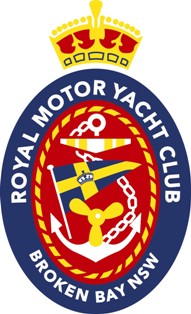 The Royal Motor Yacht Club is proud to support Woman’s Rugby and looks forward to staging an event in the near future.
The Royal Motor Yacht Club is proud to support Woman’s Rugby and looks forward to staging an event in the near future.The National Women's Rugby Sevens Championship is a national residential Championship for female players from state/territory and affiliate representative teams, conducted annually by Australian Rugby Union. The Qantas Men’s and Women’s Sevens sides are showing real potential as they work towards Olympic qualification for the 2016 Games in Rio. Our Women’s side in particular has had an incredibly successful few months and now is second in the world rankings of the IRB Women’s Sevens World Series.
In Glasgow, at the Commonwealth Games, the Australian men’s Sevens Team gained a Bronze behind South Africa (Gold) and New Zealand ( Silver) with over 180 000 people attending the four sessions. At the just finished Youth Olympics held in Nanjing, history was made when the first Olympic Rugby Gold medals for 90 years were awarded and Australia’s women’s team won every match they played and then rose above those standards to take the Gold.
Australia’s hat-trick scorer and speedster Dom du Toit summed up the emotions within a very happy squad: “It is incredible. It is hard to describe the emotions, but I am part of a very special group of girls who fight for each other every single minute and pick each other up when we are up against it.”
“This will mean a lot to Australian Rugby, to women’s Rugby and to be able to participate on such a stage is awesome for Rugby around the world.”
“For some of our squad, Rio is a reality if we qualify, and we are so pleased that Rugby Sevens is now an Olympic sport. The opportunity to represent Australia on the world’s biggest stage is very exciting.”
For the Games of the XXXI Olympiad in Rio 2016 there will be 12 Qualification Places for Men consisting of 11 teams plus one team from the Host Country and for Women another 11 teams with one team also coming from the Host Country.
To qualify for the Rio 2016 Olympics, the 31st Olympiad is no easy task. From the International Rugby Board’s (IRB) website:
Qualification Event
2014/15 IRB Women’s Sevens World Series (number of places: 4)
The teams ranked 1 to 4 in the final rankings of the 2014/15 IRB Women’s Sevens World Series will qualify directly a quota place for their NOC to the Rio 2016 Olympic Games. It is intended that the Series will consist of 6 tournaments and will commence in December 2014 and finish in May 2015.
IRB Women's Sevens World Series 2014/15 calendar:
First round: Dubai, United Arab Emirates – December 4-5, 2014
Second round: São Paulo, Brazil - February 7-8, 2015
Third round: Atlanta, Georgia, USA – March 14-15, 2015
Fourth round: Langford, British Columbia, Canada - April 18-19, 2015
Fifth round: London, UK - May 15-16, 2015
Sixth round: Amsterdam, Netherlands - May 22-23, 2015
2015 IRB Regional Association Women’s Sevens Championships (number of Places: 6)
The winner of each of the 2015 IRB Regional Association Women’s Sevens Championships will qualify for the Rio 2016 Olympic Games as follows:
o Africa (CAR) - 1 team
o Asia (ARFU) - 1 team
o Europe (FIRA-AER) - 1 team
o North America and the Caribbean (NACRA ) - 1 team
o Oceania (FORU) - 1 team
o South America (CONSUR) 1 team
All 2015 IRB Regional Association Sevens Championships are intended take place between 1 June 2015 and 31 December 2015.
So although the Women’s Seven’s has done really well, their place at Rio 2016 is not confirmed as yet. There’s a hard road ahead of them and more matches to be played that will see them travel to all corners of the earth and have to arrive fit enough to win. No easy task.
The Qantas Australian Women’s Sevens team begins its quest for Olympic qualification in Rio with Dubai first up in the IRB Women’s Sevens World Series in December. Like last season, the series will conclude in the Netherlands as part of the Amsterdam Sevens.
IRB Chairman Bernard Lapasset recently said: “The level of competition in the Women’s Sevens World Series is at an all-time high, and has been helped by the prospect of taking part in the Olympic Games in Rio in 2016.”
“We now have Canada and London added to the bill for the coming season and given the appetite for quality Rugby and the Sevens Game, I have no doubt that they will be excellent hosts when they welcome the women's series to their shores next year."
12 teams will take part in each round of the IRB Women’s Sevens World Series. Seven teams have qualified as core teams from last season’s series. Hong Kong will host a qualifying competition in September that will see an extra four teams qualify. The 12th team will be invited for each round of the series.
Australia finished the 2013-14 IRB Women’s Sevens World Series standings as runners-up, just four points behind New Zealand. Queenslander Emilee Cherry won the IRB Women’s Sevens Player of the Year.
Two weeks ago we attended a training session for the QANTAS Woman’s Seven Squad at the Sydney Academy for Sport and Recreation at Narrabeen. These young ladies are all elite athletes who have a huge passion for rugby. Working hard at building and honing skills during the practice session is an indication of the grit and determination and commitment these women have to an elite sport that has been part of our nation from its earliest times.
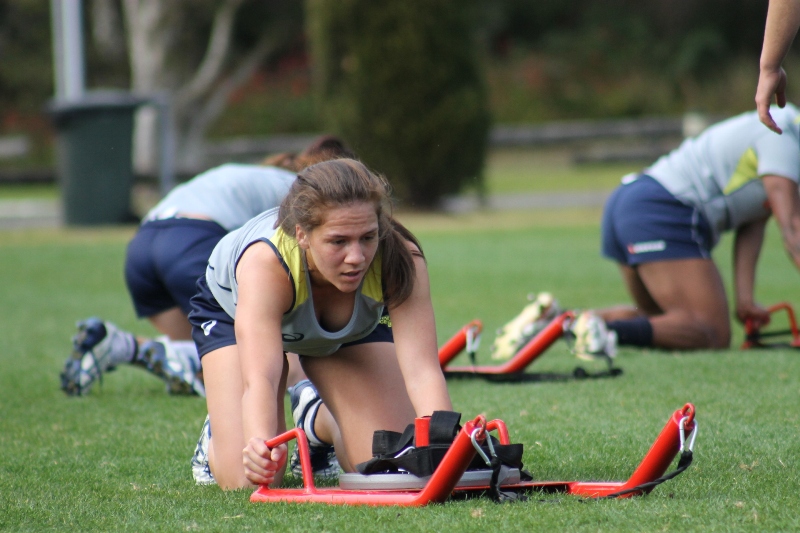
Members of the QANTAS Women’s Seven’s Squad, Maddy Elliot, Evania Pelite, Rachel Crothers and Emma Tonegato kindly answered a few questions post-training session:
Why rugby?
It’s a fast paced game with contact – we love the physicality of it.
Especially in 7’s – there’s only seven people on the field and 14 minutes of play. So every minute is high intensity for every run and you get to show off what skills you have.
It’s all of our dream to go to the Olympics and be included in the Rio 2016 Games.
What Program are you working on to get to the 2016 Rio Olympics?
Centralising here for training at Narrabeen in January was the first step; we contracted 20 girls as it’s now an Olympic funded Program and have our qualifying season coming up in the IRB circuit and there’s six stops there this year as well.
If we come in the top four in that series we qualify for the Olympics.
We usually go to the gym for our strength programs, then train and then recovery in the ice baths. We do field sessions here working on our skills, which is focusing on the rugby side of this, and then a session on the track where we do speed and conditioning running.
What is the best thing about training here at Narrabeen?
You get to train with the other girls on the team every day so we get a good feel of how to work best together. There’s also great facilities, a pool for extra work, a gym and we’re all together everyday – it’s building great team spirit. We all live nearby so we’re a close-knit group.
Is there a team motto?
We have made a little ‘credit card’ which we all keep in our wallets; which is not just a few words but our philosophy on what we are training for and our morals – this encompasses little things like ’24 hour cameras’ – so this reminds you that everything you do at home and here should be approached with integrity – all the values we have here you should carry over to when you’re at home or when you’re by yourself .
There’s also Unity with the team – we’re all one big family – that’s a really big focus for us- to be a team, not only on the field but also socialising together; to love the hard work and how that strengthens us as a team.
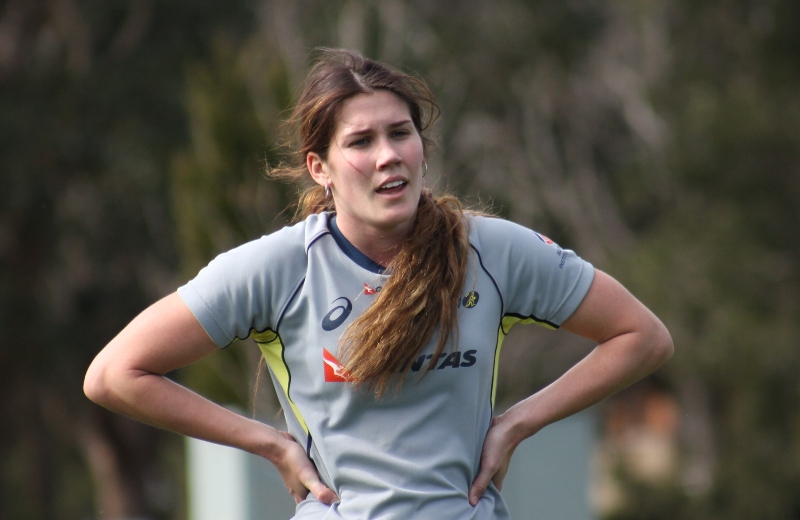
The 31st Olympiad in Rio de Janeiro will be the first held in South America and will run from 5-21 August 2016. Getting to Rio is the dream of every athlete now working hard to try and win a place on the Australian Team. In order for them to be able to concentrate on what is required the support of coaches, family and our community, from the ground up, will be required. WE can all support our local girl's dream by treating our selves to a wonderful lunch overlooking glorious Pittwater and get to meet a few current and future legends into the bargain.

Ellia Green - training at Sydney Academy of Sport, Narrabeen.

Left to right: Maddy Elliot, Evania Pelite, Rachel Crothers, Emma Tonegato
Rugby in the Olympics
Rugby 15s was played at four Olympic Games: 1900, 1908, 1920 and 1924. The following countries became Olympic Champions at rugby: France in 1900, Australia in 1908, USA in 1920 and 1924.
The following countries won medals in the Olympics rugby tournaments: France - three medals: one gold and two silvers, USA - two gold medals, Britain - one silver and one bronze, Australia - one gold medal, Germany - silver in 1900 and Romania - bronze in 1924.
Baron Pierre de Coubertin, the founder of the modern Olympic movement, played, refereed and promoted Football Rugby as it was called in his days.
The founder of the Olympics and Rugby
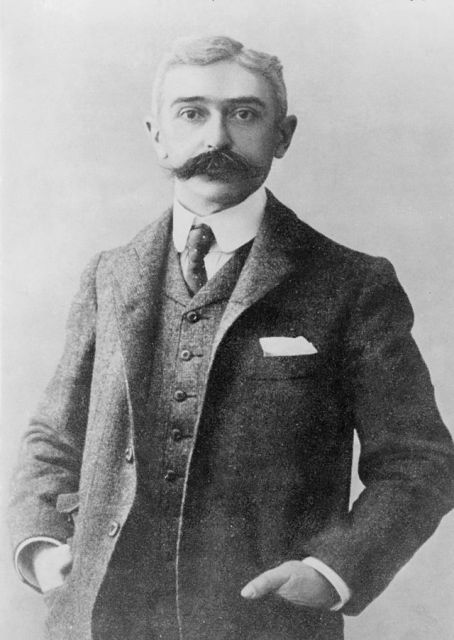 De Coubertin admired the ethos of the Game, its moral values as well as the physical and mental skills required to play it. His biographers mention boxing, fencing, rowing and horse-riding as his main sporting interests. They however failed to underline his active interest in Football Rugby, reflected in a famous essay called Notes about Foot-ball, which he wrote in 1896:
De Coubertin admired the ethos of the Game, its moral values as well as the physical and mental skills required to play it. His biographers mention boxing, fencing, rowing and horse-riding as his main sporting interests. They however failed to underline his active interest in Football Rugby, reflected in a famous essay called Notes about Foot-ball, which he wrote in 1896:
“What is admirable in football (rugby), is the perpetual mix of individualism and discipline, the necessity for each man to think, anticipate, take a decision and at the same time subordinate one’s reasoning, thoughts and decisions to those of the captain. And even the referee’s whistle stopping a player for a ‘fault’ one team mate has made and he hasn’t seen, tests his character and patience. For all that, foot-ball is truly the reflection of life, a lesson experimenting in the real world, a first-rate educational tool.”
The Baron was 25 when he visited Rugby School for the first time in 1888. By that time de Coubertin had already read both the works of Thomas Arnold, Rugby’s great headmaster and educationalist, and Thomas Hughes’ novel, Tom Brown’s Schooldays. Arnold's essays and the fortunes of young Tom Brown made a great impression on the young French aristocrat, in search of educational models for his country, traumatised by defeat in the French-Prussian war.
Right: Baron Pierre de Coubertin - 2nd President of the International Olympic Committee; In office 1896–1925
After his return from his first visit to England, de Coubertin became an active promoter of physical education in general and Rugby Football in particular, which he managed to introduce into several school establishments in Paris, securing the long term future of the Game in the country. He went on playing with his friends in Bois de Boulogne and although there is no information about his Rugby prowess, his knowledge of the Game was well respected by his peers, who elected him to referee the 1892 match between Stade Française and Racing Club de France – now regarded as the inaugural French championship.
The French educationalist became one of France's leading promoters of sport in general and Rugby in particular, and as such he played a significant role in the formation of the Union des Sociétés Français de Sports Athlétiques (USFSA) and the development of Rugby in France. He was elected to the IRB Hall of Fame in 2007.
1900 Paris Olympics
The fact that no Rugby was played in Greece at the end of the 19th century may account for the absence of the Game from the inaugural Olympic Games in 1896, but in 1900 the Baron succeeded in gathering three teams for the first Olympic Rugby competition in Paris: a Parisian selection, representing France, Frankfurt FC representing Germany and Moseley Wanderers, a selection from Midland clubs – the UK representatives.
France, captained by the legendary Frantz Reichel (one of de Coubertin’s friends), became the first Olympic Champions at Rugby by beating Frankfurt FC 27-17 and Moseley Wanderers 27-8 respectively. The match between Germany and Britain did not take place, because the English team, in the true amateur spirit of the day, having travelled to Paris the day before the match (on Saturday), had to return back home immediately after the match.
There is a dispute over whether Rugby was an ‘official’ sport in the 1900 Olympics or not, following a subsequent attempt, to sift through the numerous sporting competitions of the 1900 Paris Universal Exhibition. Unlike other events or sports which were in retrospect denied Olympic status, Rugby Football, fulfilled all criteria of an Olympic competition: it was international, (three entries France, Great Britain and Germany), was played by amateurs, was not played by motorised means and involved no handicap of any kind.
1908 London Olympics
The 1908 Games, held in London brought Rugby back into the Olympic programme. In the Olympic programme, the number of Rugby teams was limited to four and the matches were scheduled to be played "in the stadium, about October 19, 1908. Prizes: Gold Olympic medals to the winning team."
According to the official history of the 1908 Games, South Africa and New Zealand declined the invitation to play in the Olympics, while Ireland, Wales, and Scotland ignored the invitations. "That left England, France and Australia as the only competing teams. England were originally scheduled to meet France with the winners taking on Australia, but one week before the match France withdrew on the grounds that it could not raise a representative team and the two remaining teams, Australia, represented by a team selected from the touring Wallabies, and England, represented by the County Champions, Cornwall, met in the only match of the 1908 Games." The Wallabies demolished Cornwall 32-3 in a one-sided match.
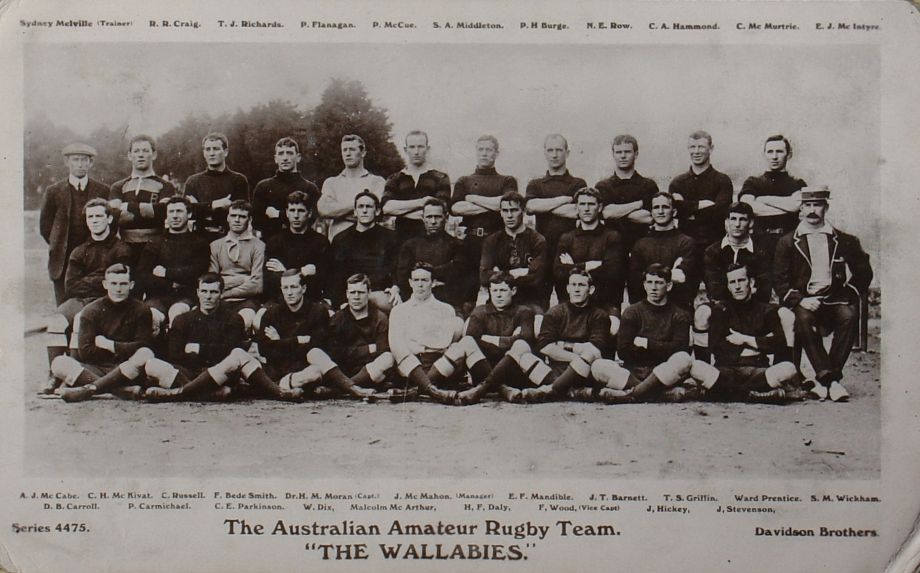
Above: The Australia national rugby union team, tour of Britain, France and North America; newer version of postcard with nickname Wallabies. (1908) - for more see: Davidson Brothers - www.flickr.com/photos/rugby_pioneers/145164414/ and Rugby Historical Society UK - see more on Australian Rugby Olympics Teams HERE and 1908–09 Australia rugby union tour of Britain
At the dinner hosted by then London RFU at which the Olympic medals were presented, the Wallaby captain, Dr Herbert Moran, replying to the toast given by Sir G Rowland Hill, the RFU President, said, "they were delighted with their reception, but deeply regretted that they had not in the Olympic Games met a side thoroughly representative of the United Kingdom. When they decided to enter they had hoped that they would conquer or be conquered by the best teams in the world..."
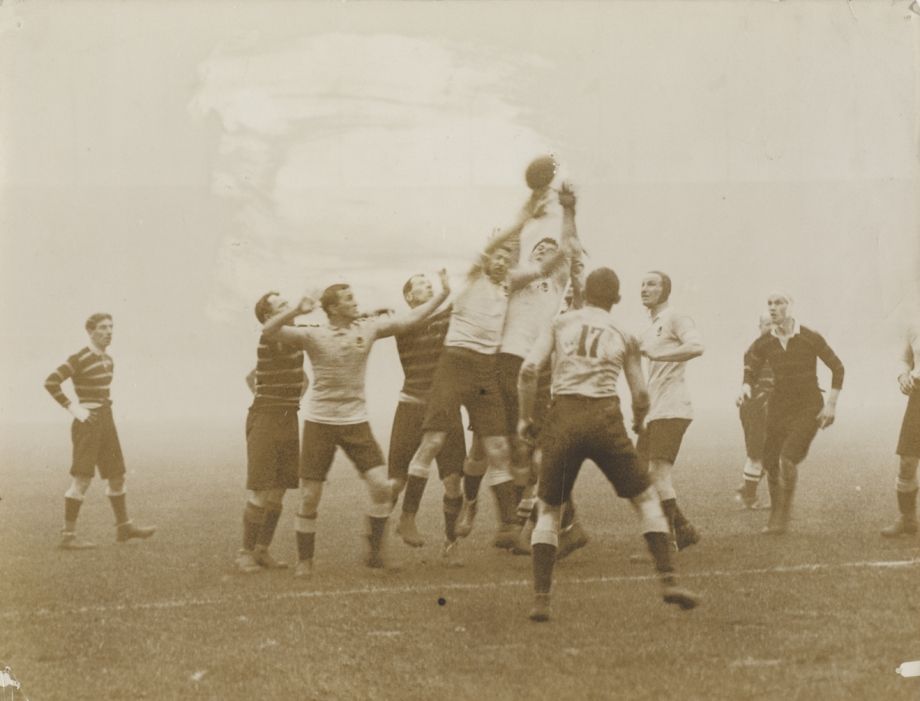
Olympic Rugby. England (Cornwall) v. Australia 1908 Gold Medal Match: Image No.: a512001. From John Corbett Davis Collection - courtesy State Library of NSW.
1920 Antwerp Olympics
Rugby was absent from the Olympic programme in 1912, but after the Great War, it re-emerged as an Olympic sport at the 1920 Games in Antwerp. The Home Unions did not take part, arguing that the event held in September was too early in the season to enable the British to compete on equal terms with the other teams. The Romanians and Czechoslovakia withdrew at the last moment, which left the USA, represented by a team of Californian students, and France as the only two competitors.
The USA, coached by former Wallaby winger Daniel Carroll, at the time a student at Stanford University in California, surprised the French with the vigour of their game and the precision of their defensive work and won the match 8-0. Daniel Carroll became rugby’s first Olympic double gold medallist.
1924 Paris Olympics
The 1924 Olympic Rugby competition commenced on the opening day, May 4, with the match between hosts France, by that time seasoned Five Nations campaigners, and Romania, newcomers at international level and making their maiden Olympic appearance. Not unexpectedly, the French dispatched the newcomers from Eastern Europe by a record margin of 61 points to 3 – according to some sources the score was actually 59-3 – scoring a record 13 tries in the process. The walkover win must have given the French players and public a sense of invincibility and high expectations, exacerbated by an intense and partisan media campaign.
On the following Sunday, May 11, the US team comprehensively defeated Romania, at Stade Colombes, though the Romanians defended gamely and managed to limit the score to 39-0, with the Americans scoring only eight tries. The defeat ended Romania’s campaign in the Olympics, but secured them the bronze, their first-ever Olympic medal. The Olympic final was played at the same Stade Colombes in Paris on May 18, before a strongly partisan crowd of about 50,000. The Americans surprised their hosts and the crowd with their pace, skill and tackling and won 17-3 scoring five tries to France’s solitary effort.
1928 - Amsterdam Olympics
In 1925, Baron de Coubertin stepped down as the President of the IOC and his successor, Count Baillet-Latour, did not share the enthusiasm of the founder for Rugby Football. The 1925 Olympic Congress, at which Baillet-Latour was elected as the second IOC President, signalled the beginning of a drive against team sports and despite the vigorous protestations of the Dutch students keen to have Rugby in the programme of the 9th Olympic Games in Amsterdam, Rugby was dropped from the Olympic programme.
Rugby in Australia
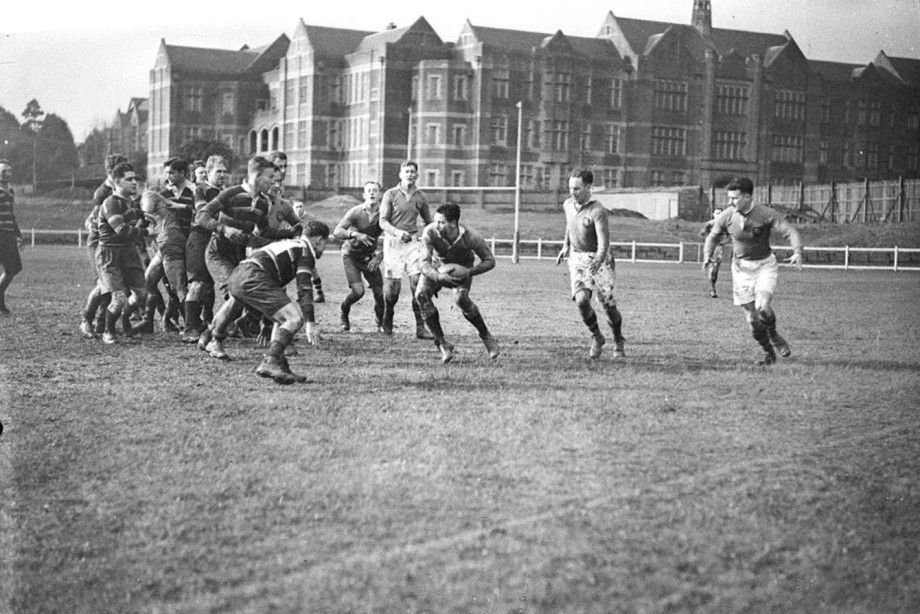
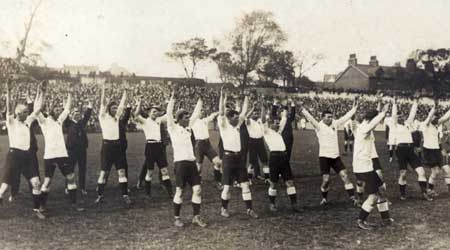 Following on the heels of a tour by the New Zealand All Blacks, the Australian team was pressured to produce a war cry similar to the Maori Haka. The team were ordered to perform an Aboriginal war cry, but were embarrassed by it. The Australian Captain Herbert 'Paddy' Moran called it the first Wallabies gravest affliction.
Following on the heels of a tour by the New Zealand All Blacks, the Australian team was pressured to produce a war cry similar to the Maori Haka. The team were ordered to perform an Aboriginal war cry, but were embarrassed by it. The Australian Captain Herbert 'Paddy' Moran called it the first Wallabies gravest affliction. 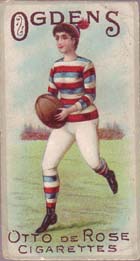 While most of these games appear to have been played to the new Association Football rules, it is clear from reports in the Liverpool Mercury of 27 June 1881 that at least one of these games, played at the Cattle Market Inn Athletic Grounds, Stanley, Liverpool on the 25th, involved scoring goals following "touchdowns" and may therefore have been played to at least a version of rugby rules.
While most of these games appear to have been played to the new Association Football rules, it is clear from reports in the Liverpool Mercury of 27 June 1881 that at least one of these games, played at the Cattle Market Inn Athletic Grounds, Stanley, Liverpool on the 25th, involved scoring goals following "touchdowns" and may therefore have been played to at least a version of rugby rules.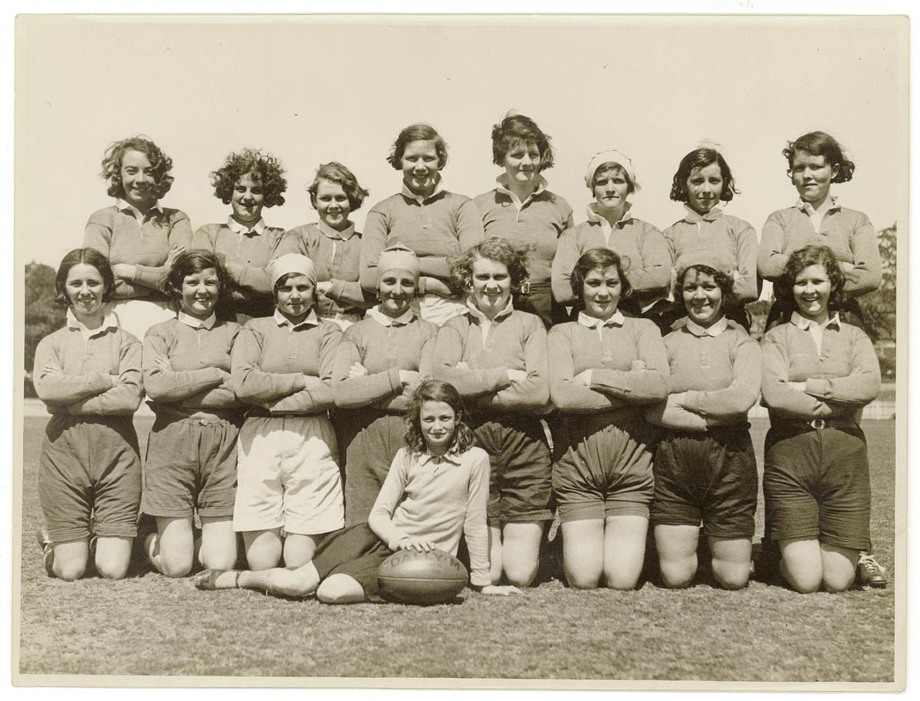
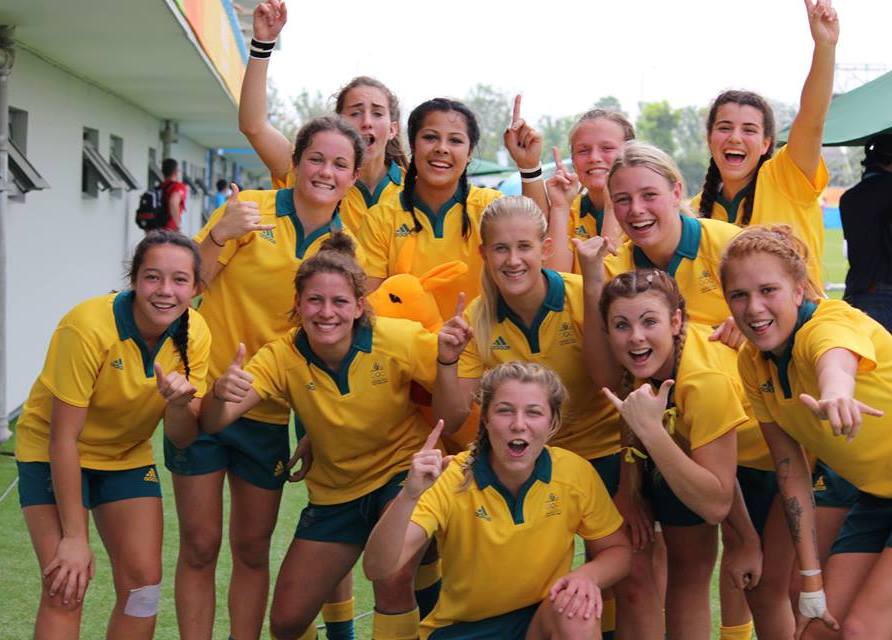
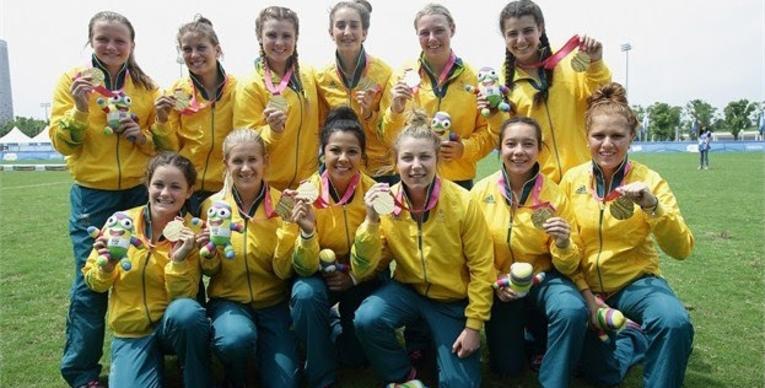
Report and QANTAS Australian Women's Sevens training images by A J Guesdon, 2014.